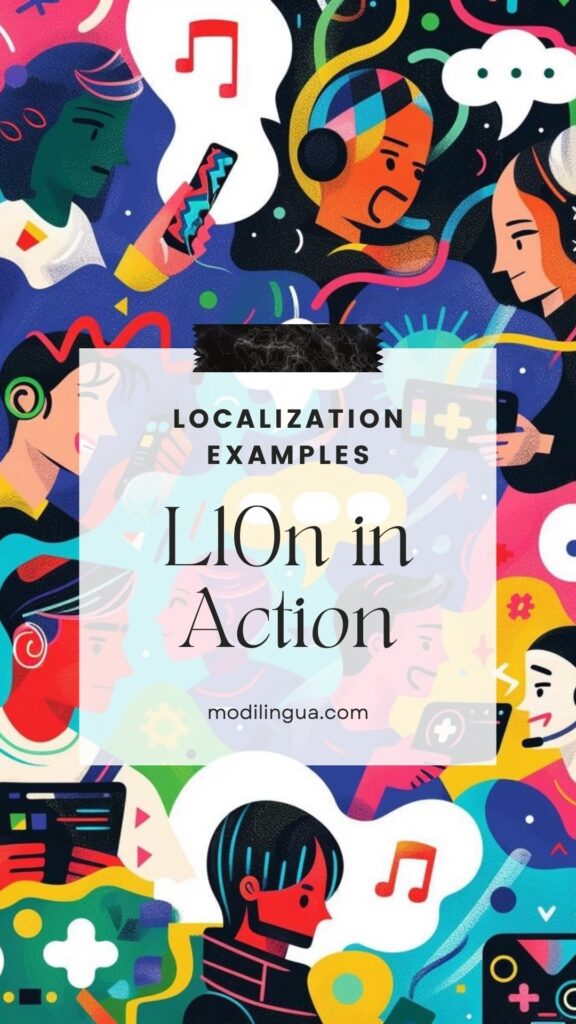You probably landed on this page because you know that businesses aiming to expand beyond their borders have to deal with the paramount importance of localization. Rather than rehashing the same localization examples you’ll find on every l10n blog out there, this post goes into the essence of what actually makes localization a pivotal component of international success.
Unpacking Localization in Business
At its core, the localization process involves adapting your product or service to align with the cultural, linguistic, and regulatory landscape of your target market. This goes beyond converting content into different languages and extends into understanding and integrating with local customs, legal requirements, and consumer behavior patterns.
Localization is a multifaceted endeavor that touches every part of your business, from the product itself to marketing, customer service, community, legal, and more. It’s ultimately about creating a customer experience that feels both personal and relevant to regional users.
Key Focus Areas for Effective Business Localization
When expanding your business across borders, you’ll want to strategically apply localization efforts across several critical areas to drive successful international growth, and this should ideally be done in an agile manner. Localization isn’t a one-time thing after all, and from optimizing digital platforms to tailoring products and enhancing customer support, an effective localization strategy and thus successful localization program will span a range of iterative decision-making processes.
Localizing the Digital Experience
A company’s online presence is often the first touchpoint for international customers, so a good localized digital experience is vital. We’re not just talking about translating website and app copy; you’ll need to adapt the user interface, navigation, and all of your core functionalities to align with local user expectations and, if applicable, compliance standards. Website localization, UI optimization, and privacy regulation adherence are three big-ticket items to tackle if you want to create a digitally engaging experience that sits well with users.
Adapting Products and Packaging for Local Markets
For physical products, the localization process extends to the offerings themselves, as well as their packaging and branding. Larger companies will often modify their products to match local tastes, values, and regulatory requirements, while also designing culturally relevant packaging that appeals to the aesthetic sensibilities of each target market. This localized approach helps ensure customers feel a stronger connection to their brand.
Cultivating Locally Relevant Marketing Initiatives
Creating marketing campaigns and content that genuinely appeal to different cultures is another aspect of business localization. This means reframing advertising messages, humor, and cultural norms and references to strike the right chord with target audiences in each region. Here again, by transforming marketing materials to reflect local narratives and values, rather than just translating them, you can build a stronger emotional connection with your consumers.
Enhancing Customer Service for Global Relevance
Exceptional customer support is a universal expectation nowadays, but its delivery should also be tailored to market preferences and sensitivities. Providing customer service in the native language is, or should be, a no-brainer by now. Training your support team on cultural nuances, and aligning your communication channels with local customer habits are also important building blocks in a good localized customer experience. Eliminating regional and cultural disparities helps foster trust and loyalty among international customers.

Localization Examples in Hypothetical Scenarios
While detailed case studies from multinationals like Nintendo, Apple, Airbnb, KFC, Coke or Netflix offer valuable insights and great examples of localization done right, they’ve been copied and pasted so often online that I’d prefer to explore some hypothetical scenarios here instead. The following examples give some viable high-level strategies as to how you could serve the right content to the right users.
Scenario 1: E-Commerce Platform Expansion into Southeast Asia
A mid-sized e-commerce platform aiming to enter the Southeast Asian market adapts its website and mobile app to offer a localized shopping experience. They implement local payment options and logistics solutions, tailoring the UI to support languages like Bahasa Indonesia, Thai, and Vietnamese, and adjust their marketing strategies to highlight regional festivals, holidays, and influential local figures. The marketing campaigns are such a hit that they wind up forging multiple new partnerships across all locales, which lead to an even greater surge in their growth.
Scenario 2: Global Launch of a Health and Wellness App
A bootstrapped health and wellness app decides to launch globally, with a focus on providing tailored content for users in different regions. They assemble an in-house team of dedicated freelancers whose localization efforts include translating the app into multiple languages, such as Spanish, French, and Korean. In parallel, they have their fractional marketing lead adapt the workout and meal plans to reflect regional dietary preferences and exercise trends. The app also incorporates region-specific health tips and even integrates local health guidelines. With relatively little overhead, they hit the ground running across all markets.
Scenario 3: Launching a Tech Gadget on the European Market
A Utah-based tech startup secures its series A and decides to go to market with its latest fitness gadget in Europe. They contract freelance country managers to customize the offering and marketing to align with local preferences. This involves offering multilingual support and user manuals in European languages, modifying product specifications to comply with EU regulations and standards, and launching marketing campaigns that resonate with European values and aesthetics, placing a huge emphasis on privacy and sustainability. Partnering with regional tech YouTubers in individual countries puts their product on the map rather quickly. The higher cost of these efforts pays for itself within one year of launch: their gadget is widely sold throughout Western Europe.
Scenario 4: Enhancing Customer Service for a Global Telecommunications Company
A major telco revamps its customer service from the ground up to provide unparalleled support across different regions. Their localization strategies include training their large customer service teams on cultural sensitivities and linguistic nuances, utilizing AI and machine translation tools to offer real-time support in over 20 languages, and adapting service hours to provide 24/7 assistance across diverse time zones. Within six months of project completion, they see their number of backlogged tickets drop by over 35% and the results of their customer satisfaction survey increase by 62%.
All four of these localization examples demonstrate the breadth and depth of localization, highlighting how businesses large and small can adapt various aspects of their operations to create personalized and resonant experiences for customers in each target market.
Strategically Overcoming Localization Barriers for Global Success
While the benefits of effective localization are clear, your business also has to navigate a range of challenges to successfully integrate localization strategies across operations. By systematically addressing these barriers, you can harness the full potential of localization to expand your footprint.

Navigating the Cultural Landscape with Precision
Understanding and respecting local culture is critical if you want to avoid costly missteps when localizing your content and offerings. You’ll want to work with a culturalization consultant to get a really firm grasp of the customs, values, and taboos of your target markets in order to ensure all communication, from marketing materials to product names, resonates without offense or legal risk. Apart from that, leveraging the insights of localization experts and native speakers is crucial for fine-tuning content to align with local language and norms, especially if you’ve been working with AI-generated content drafts.
Balancing Global Brand Identity and Local Relevance
Maintaining a consistent brand identity while adapting to local markets is a delicate balance. Successful companies employ a flexible brand strategy that allows for strategic variations to appeal to regional preferences, without diluting the core brand essence. This may involve utilizing translation and localization services to adapt marketing campaigns and advertising in a way that reflects the brand’s voice while resonating with local tastes.
Tackling Technical Complexities in Digital Localization
The technical aspects of localizing digital content, platforms, and video games in particular present their own set of challenges. Overcoming these requires implementing robust translation management systems and content management solutions capable of handling multiple languages. You also want to make sure your user interface and user experience (UI/UX) are fully localized, and that might mean sending your team back to the drawing board to redesign layouts to accommodate right-to-left languages or integrate local payment methods.
Best Practices for Localization Success
To harness the full power of localization, businesses must embrace certain best practices that not only bridge cultural gaps but also drive market relevance and growth. Four things should always be front of mind:
Conduct In-depth Market Research
Take the time to go deep into the cultural fabric, consumer behaviors, and market dynamics of your target locales. Utilize both quantitative data and qualitative insights to inform your localization strategies and ensure you have a comprehensive understanding of each market.
Engage with Local Talent and Experts
Build partnerships with local experts, translators, and consultants who can bring invaluable local perspectives and expertise to your localization efforts. Their insights will help ensure authenticity, relevance, and cultural sensitivity across your adapted offerings.
Leverage Advanced Localization Technologies
The software landscape is constantly shifting. Don’t shy away from testing the latest in localization and content technologies, from content management systems (CMS) to AI and machine translation. You might find something that is a better fit, and leveraging new tools can help refine your localization processes, improve efficiency, and further scale your global reach.
Adopt an Agile Localization Approach
Treat localization as a dynamic, ongoing process. Regularly review and iterate on your strategies based on user feedback, market trends, and evolving customer needs. An agile mindset will allow you to stay closely aligned with the preferences and expectations of your international customer base.
The Evolution of Business Localization
Looking ahead, the localization landscape is poised for dynamic changes, fueled by technological innovation and market evolution. As companies navigate the increasingly globalized business landscape, they must stay attuned to emerging trends that will shape the future of localization strategies.
Embracing AI and Machine Learning
The advent of AI-driven tools and machine learning algorithms is redefining localization approaches as I write these words, making real-time, context-aware translations and cultural adaptations more easily accessible to even the lowest budgets. Unlike us humans, AI is here to stay, and smart businesses are using it in their daily workflows to deliver more personalized experiences to their customers worldwide. You should, too.
Capitalizing on Digital Expansion
With the digital economy continuing to expand, businesses have unprecedented opportunities to reach global audiences through e-commerce and digital platforms. It’s probably never actually been easier to earn money in the history of humankind as it is today. Yet this digital-first landscape only heightens the need for nuanced localization strategies that can seamlessly adapt content, user interfaces, and customer experiences for a range of international markets.

Preparing for Future Trends
Businesses which proactively adopt emerging technologies and tailor their localization efforts to fit the evolving needs of digitally-savvy, globally-connected consumers will enjoy a distinct competitive edge in the years to come. By staying ahead of the curve, companies can future-proof their global expansion strategies and cement their position as leaders in their respective industries.
The importance of business localization is only going to grow. See what you can adapt and iterate on from the above localization examples. If you get on board with this strategic imperative and invest in developing agile, technology-driven localization capabilities you’ll be way better positioned to forge deeper, lasting connections with your users across different markets.
